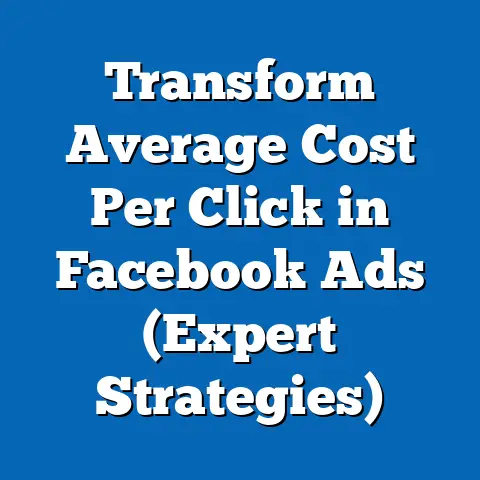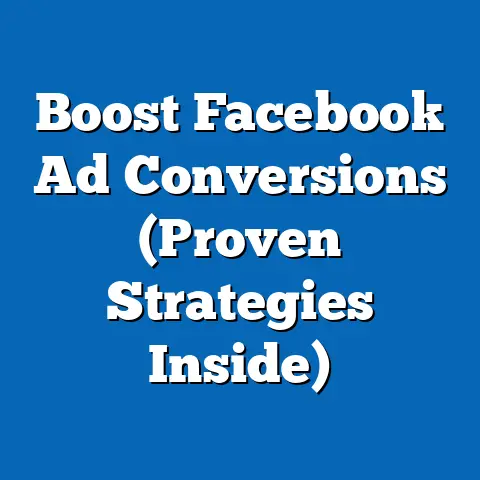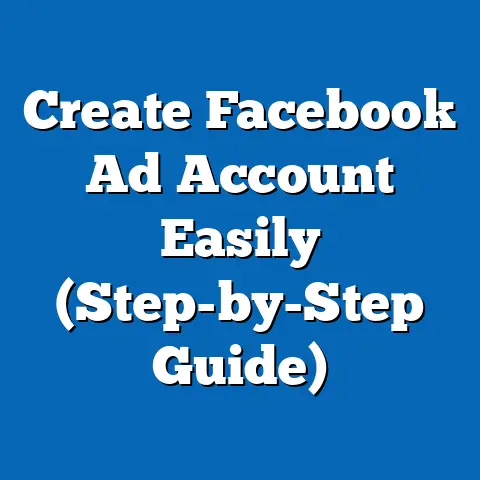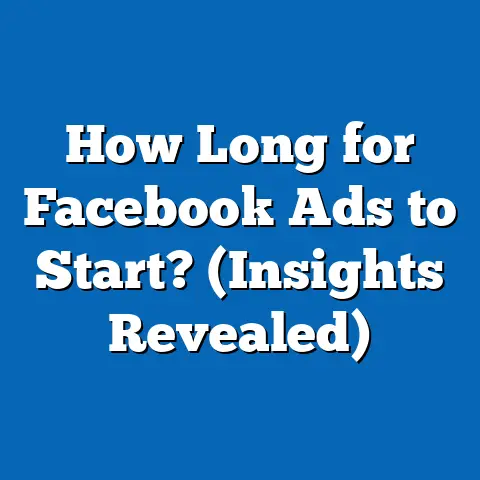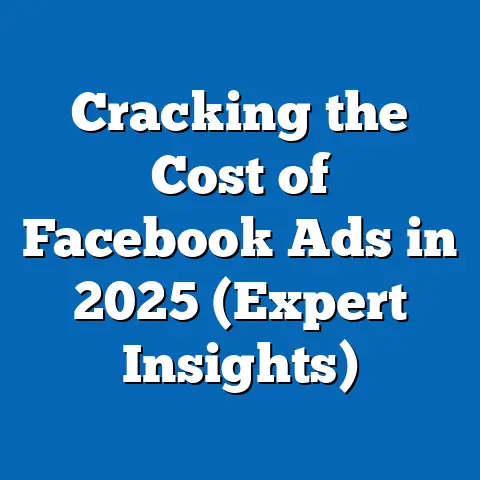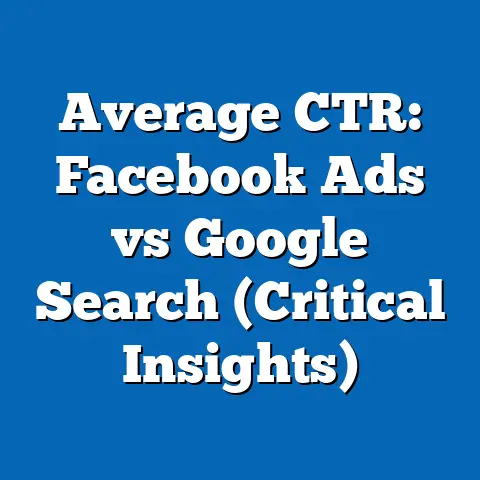Revamp Facebook Ads with Stunning Templates (Expert Guide)
What if you could transform your Facebook ads from something that blends into the newsfeed to eye-catching masterpieces that not only grab attention but also significantly boost your conversion rates? I’ve spent years helping businesses navigate the ever-changing world of Facebook advertising, and one thing has become crystal clear: visual appeal is paramount. In this guide, I’ll share my insights on how you can leverage the power of stunning templates to revolutionize your Facebook ad campaigns.
The Importance of Visual Appeal in Facebook Ads
In today’s fast-paced digital landscape, attention spans are shorter than ever. Social media users are bombarded with content, and your Facebook ads have just a fraction of a second to make an impression. That’s where visual appeal comes in. It’s not just about having a pretty picture; it’s about crafting a visual narrative that resonates with your target audience and compels them to take action.
Think about it: how many times have you scrolled past an ad simply because it didn’t catch your eye? I know I’ve done it countless times. A visually compelling ad, on the other hand, can stop users in their tracks and draw them in.
According to a study by HubSpot, visual content is 40 times more likely to be shared on social media than other types of content. This statistic alone underscores the importance of investing in high-quality visuals for your Facebook ads. Moreover, research from the Nielsen Norman Group shows that users pay close attention to information-carrying images that show real people.
I’ve seen firsthand how a well-designed ad can transform a struggling campaign into a roaring success. For instance, I worked with a local bakery that was seeing dismal results from their Facebook ads. Their ads featured grainy photos of their products and generic text. After revamping their ads with professional templates and high-quality images, their click-through rate increased by 300%, and their sales skyrocketed.
In a crowded marketplace where everyone is vying for attention, a well-designed ad can be the difference between success and obscurity. It’s not enough to simply have a great product or service; you need to present it in a way that captivates your audience and makes them want to learn more.
Takeaway: Visual appeal is critical for capturing attention and driving engagement on Facebook. Invest in high-quality visuals to stand out from the competition and improve your ad performance.
Understanding Facebook Ad Formats
Facebook offers a diverse range of ad formats, each with its unique characteristics and advantages. Understanding these formats is crucial for selecting the right one for your campaign and tailoring your templates accordingly.
Here’s a breakdown of some of the most popular Facebook ad formats:
- Image Ads: These are the simplest and most common type of Facebook ad. They consist of a single image, headline, text, and a call-to-action button. Image ads are great for showcasing products, promoting events, or driving traffic to your website.
- Video Ads: Video ads are highly engaging and can be used to tell compelling stories, demonstrate product features, or capture attention with motion graphics. They can be short, attention-grabbing clips or longer, more informative videos.
- Carousel Ads: Carousel ads allow you to showcase multiple images or videos within a single ad unit. Users can scroll through the carousel to view each item, making it ideal for showcasing a range of products, highlighting different features, or telling a story in a sequential manner.
- Slideshow Ads: Slideshow ads are similar to video ads but use a series of still images to create a video-like experience. They are a cost-effective alternative to video ads and can be easily created using Facebook’s built-in tools.
When choosing an ad format, it’s important to consider your campaign goals, target audience, and the type of content you want to share. For example, if you’re promoting a new product line, a carousel ad might be the best option. If you’re trying to build brand awareness, a video ad could be more effective.
Templates play a vital role in ensuring that your ads maintain a consistent brand identity across different formats. By using templates, you can easily adapt your visual elements, messaging, and branding to fit each ad format while maintaining a cohesive look and feel.
I’ve found that many businesses struggle with creating visually appealing ads that are optimized for different formats. This is where templates come in handy. They provide a structured framework that simplifies the design process and ensures that your ads look professional, regardless of the format you choose.
Takeaway: Understanding the different Facebook ad formats is essential for selecting the right one for your campaign and tailoring your templates accordingly. Use templates to maintain brand consistency across all your ads.
The Benefits of Using Templates for Facebook Ads
Using templates for your Facebook ads offers a multitude of benefits, from saving time and ensuring quality design to enhancing creativity and maintaining brand identity. Let’s explore some of these advantages in more detail:
- Saving Time: Creating Facebook ads from scratch can be time-consuming, especially if you’re not a professional designer. Templates provide a pre-designed framework that you can quickly customize with your own content, saving you valuable time and effort.
- Ensuring Quality Design: Templates are created by professional designers who understand the principles of visual communication and user experience. By using templates, you can ensure that your ads look polished and professional, even if you don’t have design expertise.
- Maintaining Brand Identity: Templates allow you to easily incorporate your brand colors, fonts, and logo into your Facebook ads, ensuring that they align with your overall brand identity. This helps to create a consistent brand experience for your audience and reinforces brand recognition.
- Enhancing Creativity: While templates provide a structured starting point, they also offer opportunities for creativity. You can customize templates to reflect your unique brand personality and experiment with different visual elements to create ads that stand out.
I’ve seen firsthand how templates can empower businesses to create stunning Facebook ads without breaking the bank. One of my clients, a small e-commerce store, was struggling to create visually appealing ads on a limited budget. After introducing them to templates, they were able to create professional-looking ads that significantly improved their click-through rates and conversion rates.
“Using templates has been a game-changer for our Facebook advertising,” says Sarah, the owner of the e-commerce store. “We can now create high-quality ads in a fraction of the time, and our ads look much more professional. This has helped us to attract more customers and grow our business.”
Another benefit of using templates is that they can help to streamline your ad creation process. By having a library of pre-designed templates, you can quickly create new ads whenever you need them, without having to start from scratch each time.
Takeaway: Using templates for your Facebook ads offers numerous benefits, including saving time, ensuring quality design, maintaining brand identity, and enhancing creativity.
Key Elements of Stunning Facebook Ad Templates
Creating stunning Facebook ad templates involves careful consideration of several key elements, including layout, color schemes, typography, and imagery. Let’s delve into each of these elements and explore how they contribute to an effective ad design:
- Layout: The layout of your ad template should be clean, organized, and visually appealing. Use a grid system to create a balanced composition and ensure that your elements are aligned properly. Pay attention to whitespace to avoid clutter and allow your message to breathe.
- Color Schemes: Choose a color scheme that aligns with your brand identity and target audience preferences. Use a color palette that is harmonious and visually appealing. Consider using contrasting colors to draw attention to key elements, such as your call-to-action button.
- Typography: Select fonts that are legible and consistent with your brand identity. Use a hierarchy of font sizes to create visual interest and guide the viewer’s eye. Avoid using too many different fonts, as this can make your ad look cluttered and unprofessional.
- Imagery: Use high-quality images or videos that are relevant to your message and visually appealing. Choose images that feature real people or showcase your products in an attractive way. Ensure that your images are properly sized and optimized for Facebook’s ad specifications.
When choosing these elements, it’s important to consider your target audience and the overall message you want to convey. For example, if you’re targeting a younger audience, you might want to use a more vibrant color scheme and modern typography. If you’re promoting a luxury product, you might want to use a more sophisticated and elegant design.
I’ve found that many businesses make the mistake of using generic or low-quality images in their Facebook ads. This can significantly detract from the overall effectiveness of the ad. Investing in high-quality imagery is essential for creating ads that capture attention and resonate with your audience.
Takeaway: An effective Facebook ad template incorporates a well-designed layout, a harmonious color scheme, legible typography, and high-quality imagery.
Tools and Resources for Creating Facebook Ad Templates
Creating stunning Facebook ad templates doesn’t have to be a daunting task. There are numerous design tools and resources available that can help you create professional-looking ads, regardless of your skill level. Here are some of the most popular options:
- Canva: Canva is a user-friendly design tool that offers a wide range of pre-designed templates, graphics, and fonts. It’s a great option for beginners and those who want to quickly create visually appealing ads without having to learn complex design software. Canva offers both free and paid plans, with the paid plans providing access to additional features and templates.
- Adobe Spark: Adobe Spark is another popular design tool that offers a range of templates and tools for creating social media graphics, videos, and web pages. It’s a good option for those who want to create more sophisticated designs and have some experience with design software. Adobe Spark is included with an Adobe Creative Cloud subscription.
- Figma: Figma is a collaborative design tool that is popular among professional designers. It offers a wide range of advanced features and is ideal for creating complex and highly customized ad templates. Figma is a paid tool, but it offers a free plan for individuals and small teams.
- Creative Market: Creative Market is an online marketplace where you can purchase pre-made templates, graphics, and fonts. It’s a great option for those who want to quickly find high-quality design assets without having to create them from scratch.
- Envato Elements: Envato Elements is a subscription-based service that offers unlimited access to a vast library of design assets, including templates, graphics, fonts, and stock photos. It’s a good option for those who need a lot of design assets and want to save money in the long run.
When choosing a design tool or resource, it’s important to consider your budget, skill level, and the type of ads you want to create. If you’re a beginner, Canva might be the best option. If you’re a professional designer, Figma might be a better fit.
I’ve found that many businesses are hesitant to invest in design tools or resources, but the return on investment can be significant. By using these tools, you can create ads that are more visually appealing, more engaging, and more likely to drive conversions.
Takeaway: There are numerous design tools and resources available that can help you create stunning Facebook ad templates. Choose the option that best fits your budget, skill level, and design needs.
Step-by-Step Guide to Designing Your Own Facebook Ad Template
Now that you understand the key elements of stunning Facebook ad templates and the tools and resources available, let’s walk through a step-by-step guide to designing your own template using Canva:
- Step 1: Setting up the Canvas:
- Log in to your Canva account or create a new one.
- Click on the “Create a design” button and select “Facebook Ad.” This will automatically set the canvas dimensions to the recommended size for Facebook ads (1200 x 628 pixels).
- Step 2: Choosing a Template or Starting from Scratch:
- Browse Canva’s library of pre-designed Facebook ad templates. You can filter templates by industry, style, or ad format.
- If you want to start from scratch, select a blank canvas.
- Step 3: Adding Elements:
- Add images, text, and call-to-action buttons to your template.
- You can upload your own images or choose from Canva’s library of stock photos and graphics.
- Use Canva’s text tool to add headlines, body text, and captions.
- Add a call-to-action button to encourage users to take action.
- Step 4: Customizing Colors and Fonts:
- Customize the colors and fonts to match your brand guidelines.
- Use Canva’s color palette tool to select your brand colors.
- Choose fonts that are legible and consistent with your brand identity.
- Step 5: Reviewing and Optimizing:
- Review your template to ensure that it is visually appealing and effectively communicates your message.
- Optimize your template for mobile and desktop views. Use Canva’s preview tool to see how your ad will look on different devices.
- Download your template in the recommended format for Facebook ads (JPEG or PNG).
- Log in to your Canva account or create a new one.
- Click on the “Create a design” button and select “Facebook Ad.” This will automatically set the canvas dimensions to the recommended size for Facebook ads (1200 x 628 pixels).
- Browse Canva’s library of pre-designed Facebook ad templates. You can filter templates by industry, style, or ad format.
- If you want to start from scratch, select a blank canvas.
- Add images, text, and call-to-action buttons to your template.
- You can upload your own images or choose from Canva’s library of stock photos and graphics.
- Use Canva’s text tool to add headlines, body text, and captions.
- Add a call-to-action button to encourage users to take action.
- Customize the colors and fonts to match your brand guidelines.
- Use Canva’s color palette tool to select your brand colors.
- Choose fonts that are legible and consistent with your brand identity.
- Review your template to ensure that it is visually appealing and effectively communicates your message.
- Optimize your template for mobile and desktop views. Use Canva’s preview tool to see how your ad will look on different devices.
- Download your template in the recommended format for Facebook ads (JPEG or PNG).
Throughout this process, remember to keep your target audience and campaign goals in mind. Your template should be designed to capture their attention and compel them to take action.
I’ve found that many businesses get stuck on the design process and never actually launch their ads. Don’t let perfection be the enemy of progress. It’s better to launch an imperfect ad and iterate based on the results than to never launch at all.
Takeaway: Designing your own Facebook ad template is a straightforward process that can be easily accomplished using Canva. Follow these steps to create a visually appealing and effective template that aligns with your brand identity and campaign goals.
Best Practices for Implementing Facebook Ad Templates
Implementing Facebook ad templates effectively requires more than just creating a visually appealing design. You need to test, iterate, and analyze your ads to ensure that they are driving the desired results. Here are some best practices for implementing Facebook ad templates:
- Test and Iterate: Don’t be afraid to experiment with different versions of your ad templates. Try different headlines, images, call-to-action buttons, and color schemes to see what resonates best with your audience. Use A/B testing to compare the performance of different ad variations and identify the most effective elements.
- Analyze Ad Performance: Regularly monitor your ad performance metrics, such as click-through rate, conversion rate, and cost per acquisition. Use this data to identify areas for improvement and make data-driven adjustments to your templates.
- Optimize for Mobile: Ensure that your ad templates are optimized for mobile devices. The majority of Facebook users access the platform on their mobile devices, so it’s essential that your ads look good and function properly on smartphones and tablets.
- Maintain Brand Consistency: While it’s important to test and iterate on your ad templates, it’s also important to maintain brand consistency. Ensure that your ads align with your overall brand identity and messaging.
- Stay Up-to-Date: Facebook’s ad platform is constantly evolving, so it’s important to stay up-to-date on the latest features and best practices. Follow industry blogs, attend webinars, and experiment with new ad formats to stay ahead of the curve.
I’ve seen many businesses make the mistake of creating a set of ad templates and then never touching them again. This is a missed opportunity. The most successful Facebook advertisers are constantly testing, iterating, and optimizing their ads to improve performance.
Takeaway: Implementing Facebook ad templates effectively requires testing, iteration, analysis, and optimization. By following these best practices, you can maximize the impact of your ads and drive better results.
Real-World Examples of Successful Facebook Ads Using Templates
To illustrate the power of stunning templates in Facebook ads, let’s take a look at some real-world examples of brands that have successfully revamped their ads using templates:
- Example 1: Airbnb: Airbnb uses templates to showcase their unique accommodations and experiences. Their ads feature high-quality images, compelling headlines, and clear call-to-action buttons. They also use consistent branding across all their ads, which helps to reinforce brand recognition. The success of Airbnb’s Facebook ads lies in their ability to create a sense of wanderlust and inspire users to book their next trip.
- Example 2: Shopify: Shopify uses templates to promote their e-commerce platform and showcase their success stories. Their ads feature testimonials from satisfied customers, as well as compelling visuals and clear calls-to-action. Shopify’s Facebook ads are successful because they provide social proof and demonstrate the value of their platform.
- Example 3: Nike: Nike uses templates to promote their athletic apparel and footwear. Their ads feature high-quality images of athletes wearing Nike products, as well as inspiring taglines and clear calls-to-action. Nike’s Facebook ads are successful because they tap into the emotions of their target audience and inspire them to achieve their fitness goals.
These examples demonstrate how brands can use templates to create visually appealing and effective Facebook ads that drive engagement and conversions. The key takeaways from these examples are:
- Use high-quality images and videos.
- Craft compelling headlines and taglines.
- Include clear calls-to-action.
- Maintain brand consistency.
- Tap into the emotions of your target audience.
I’ve found that many businesses underestimate the importance of studying successful Facebook ads. By analyzing what works for other brands, you can gain valuable insights and apply those lessons to your own ad campaigns.
Takeaway: Studying real-world examples of successful Facebook ads can provide valuable insights and inspiration for your own ad campaigns. Pay attention to the design choices, messaging, and branding of these ads to learn what works and apply those lessons to your own templates.
Conclusion
In conclusion, stunning templates have the transformative power to revolutionize your Facebook ads, turning them into attention-grabbing masterpieces that drive engagement and boost conversions. By understanding the importance of visual appeal, selecting the right ad formats, leveraging the benefits of templates, and implementing best practices, you can create Facebook ad campaigns that stand out from the crowd and deliver exceptional results.
Now is the time to take actionable steps toward revamping your ad strategies with the insights and tools provided throughout this guide. Envision the success you could achieve by implementing these strategies and start creating stunning Facebook ads that captivate your audience and propel your business forward. I encourage you to experiment with different templates, test different ad variations, and continuously optimize your campaigns to achieve your advertising goals. The world of Facebook advertising is constantly evolving, and by staying informed and adaptable, you can unlock the full potential of this powerful platform.

